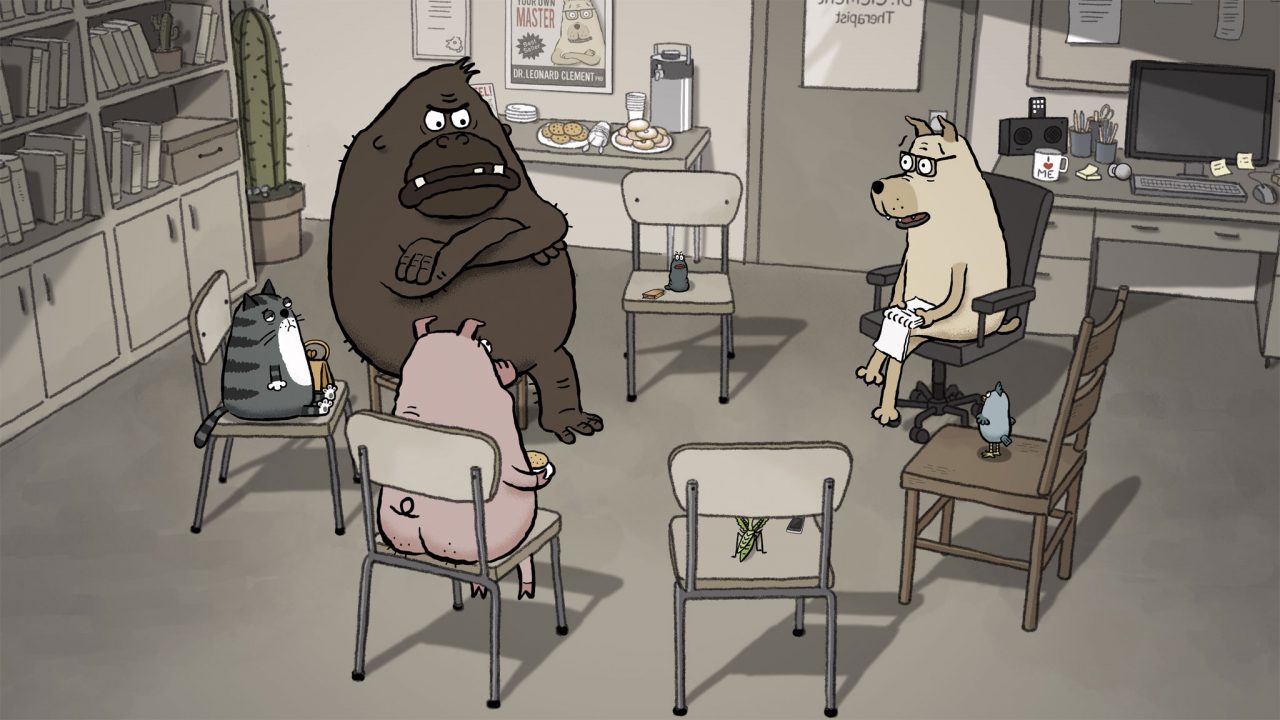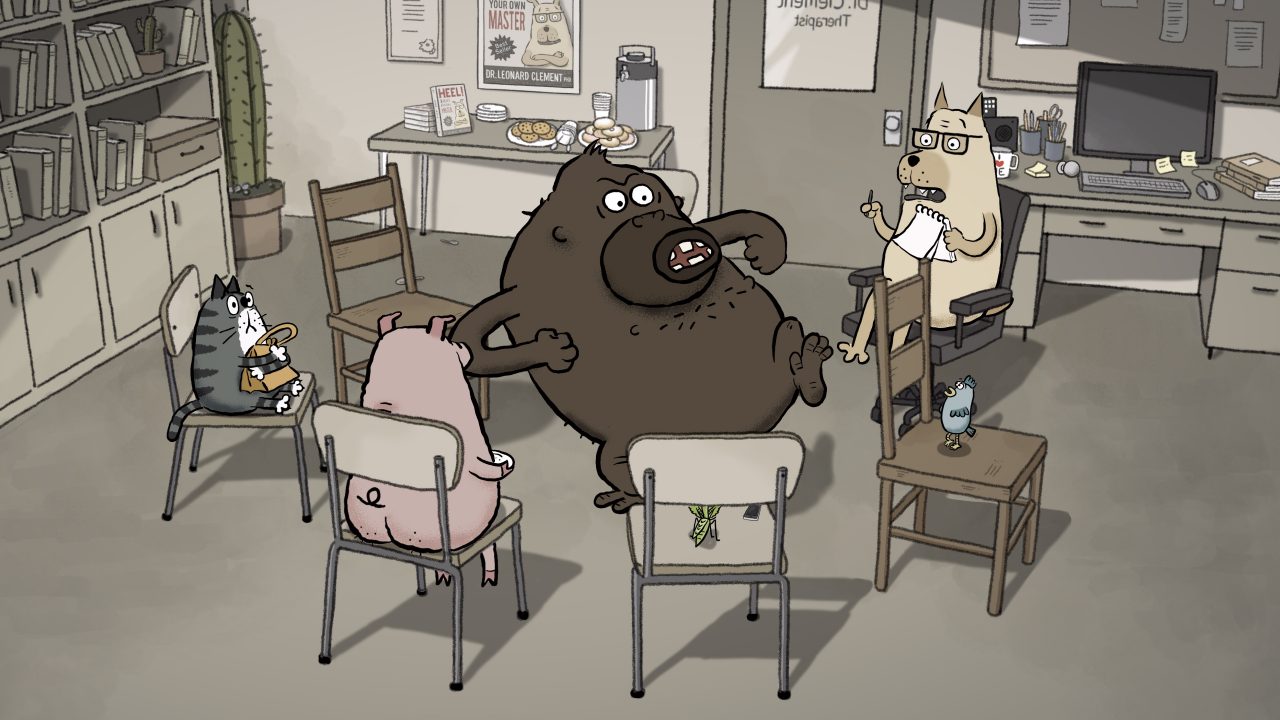
Mini-Lesson for Animal Behaviour
Mini-Lesson for Animal Behaviour
Mini-Lesson for Animal Behaviour
Themes:
- Family Studies/Home Economics – Relationships
- Health/Personal Development – Mental Health/Stress/Suicide
- Problem-Solving/Conflict Resolution
- Human Growth and Development
- Identity
- Healthy Relationships
Ages: 15–17
Animal Behaviour, Alison Snowden & David Fine, provided by the National Film Board of Canada
Keywords/Topics: Mental Health, Behaviour, Therapy, Relationships, Instincts, Expectations, Society
Guiding Question: Under what circumstances should we be willing to change who we are and how we behave in order to meet the expectations of those around us?
Summary: Animal Behaviour is an animated short film that centres around a group therapy session attended by animals, who are attempting to overcome their natural instincts in order to better function within mainstream society. Educators should note that, while the film is humorous, the subject matter may trigger students who suffer from the mental illnesses and issues depicted in the film (addiction, obsessive-compulsive disorder, guilt issues, anger-management issues, and unhealthy relationships). The illnesses and issues are not specifically named but their typical behavioural characteristics are shown. It’s also important that educators establish a respectful classroom environment to avoid having students draw comparisons between the characters in the film and their classmates.
Before Watching: Consider whether you strongly agree, agree, disagree, or strongly disagree with this statement: Sometimes we have to change who we truly are in order to be accepted by those around us. Once you’ve decided how you feel about this statement, find others in the class who chose the same response you did. Discuss why you selected that response. One student should be a note taker for the group. Select a spokesperson for your group, who will share the main points of your discussion with the rest of the class. When all groups have had their chance to speak, consider whether you’ve changed your mind about your response.
Activity 1) Watch, Talk, Write
All the characters featured in this film are attempting to change things about themselves through group therapy. As you watch the short, it will become clear what it is that each character is trying to change. Thinking about the characters in this segment (Lorraine the leech, Cheryl the praying mantis, Todd the pig, Jeffrey the bird, Linda the cat, and Leonard the dog), rank them in order of who will have the most difficulty trying to change to who will have the least difficulty. After you’ve ranked the characters, talk with a partner/small group about where you placed the characters on your list and why. After discussing, write a paragraph that describes in detail which character you believe will have the most difficulty changing and why.
Go Deeper
Write a journal entry from the point of view of the character you chose. The journal entry should touch on the daily struggles faced by the character and the strategies the character is using in an attempt to overcome these struggles. You may have to do some research on the particular illness you believe the character suffers from (addiction, obsessive-compulsive disorder, guilt issues, eating disorders, etc.).
Activity 2) Think-Pair-Share
Leonard seems to be able to keep everything under control until this segment, in which we see him resort to growling, barking, and ultimately playing fetch (instinctual behaviour for a dog). Thinking of the ways in which we behave and how we interact with others, are there things about ourselves that we cannot change? Consider that the animals used in this film all exhibit problematic behaviours that are actually instinctual. Do humans have similar instincts? Write a short response, then discuss what you wrote with a partner. After discussing, you and your partner will share your thoughts during a whole-class discussion.
Go Deeper
Research suggests that our past experiences, the people in our lives, and our biology all play a role in determining who we are as people. How might a person be able to overcome these factors to become the person they want to be?
Activity 3) Give One, Get One
In this segment, we see Victor experience a change in his demeanour. When he first enters therapy, he believes his behaviour is normal for an ape and sees no reason to change. By the time the session is over, Victor is in tears and wants to change. What motivates Victor to want to change? What motivates us to make changes in our own behaviour? Create two lists. One will be a list of external factors (e.g., peer pressure) and the other a list of internal factors (e.g., improving your health). Write down at least three factors for each list. Once you have three factors on each list, circulate throughout the classroom, meeting with other students. You will give one of your factors to each student you meet, and they will give you one of their factors in return. You cannot exchange more than one factor with the same student. Exchange factors with at least five other students.
Go Deeper
After examining both the internal and external factors that motivate us to make changes in our behaviour, which type do you believe to be the more powerful motivators? Are we more likely to change our behaviour when it benefits us, or are we more likely to make changes in order to meet the expectations of others? Which types of motivating factors do you believe will lead to more lasting change? Write a paragraph addressing these questions.
Chris Gallant has been an English Language Arts and Social Studies teacher at Allison Bernard Memorial High School for the past 13 years. He is dedicated to social justice issues and attempts to incorporate Mi’kmaw language and culture into his teaching at every opportunity. As a visual learner, Chris understands the importance of using film in the classroom.
Pour lire cet article en français, cliquez ici.
Discover more Mini-Lessons | Watch educational films on NFB Education | Watch educational playlists on NFB Education | Follow NFB Education on Facebook | Follow NFB Education on Pinterest | Subscribe to the NFB Education Newsletter



